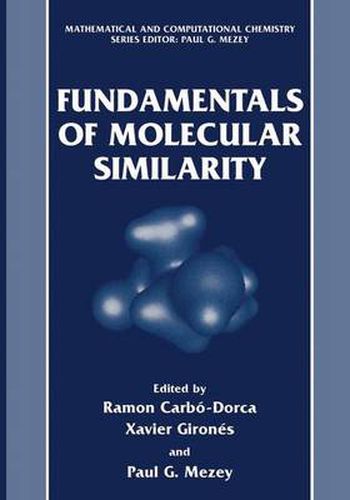Readings Newsletter
Become a Readings Member to make your shopping experience even easier.
Sign in or sign up for free!
You’re not far away from qualifying for FREE standard shipping within Australia
You’ve qualified for FREE standard shipping within Australia
The cart is loading…






This title is printed to order. This book may have been self-published. If so, we cannot guarantee the quality of the content. In the main most books will have gone through the editing process however some may not. We therefore suggest that you be aware of this before ordering this book. If in doubt check either the author or publisher’s details as we are unable to accept any returns unless they are faulty. Please contact us if you have any questions.
In recent years the fundamental concepts and applied methodologies of molecular similarity analysis have experienced a revolutionary development. Motivated by the increased degree of understanding of elementary molecular properties on the levels ranging from fundamental quantum chemistry to the complex interactions of biomolecules, and aided by the spectacular progress in computer technology and access to computer power, the area has opened up to many new ideas and new approaches. This book covers topics in quantum similarity approaches, electron density shape analysis methods, and it provides better theoretical understanding of molecular similarity. Additionally, quantitative shape analysis, especially activity relations (QShAR) and the prediction of the pharmacological or toxicological effects of molecules in the related context of quantum QSAR (QQSAR). This volume written by the experts in the various subfields of molecular similarity, provides a collection of the most recent ideas, advances, and methodologies. It is the hope of the Editors that by representing these topics within a single volume, the readers will find a balanced overview of the status of the field. We also hope that the book will serve as a tool for selecting and assessing the best approach for various new types of problems of molecular similarity that may arise and it will provide a set of easy references for further studies and applications.
$9.00 standard shipping within Australia
FREE standard shipping within Australia for orders over $100.00
Express & International shipping calculated at checkout
This title is printed to order. This book may have been self-published. If so, we cannot guarantee the quality of the content. In the main most books will have gone through the editing process however some may not. We therefore suggest that you be aware of this before ordering this book. If in doubt check either the author or publisher’s details as we are unable to accept any returns unless they are faulty. Please contact us if you have any questions.
In recent years the fundamental concepts and applied methodologies of molecular similarity analysis have experienced a revolutionary development. Motivated by the increased degree of understanding of elementary molecular properties on the levels ranging from fundamental quantum chemistry to the complex interactions of biomolecules, and aided by the spectacular progress in computer technology and access to computer power, the area has opened up to many new ideas and new approaches. This book covers topics in quantum similarity approaches, electron density shape analysis methods, and it provides better theoretical understanding of molecular similarity. Additionally, quantitative shape analysis, especially activity relations (QShAR) and the prediction of the pharmacological or toxicological effects of molecules in the related context of quantum QSAR (QQSAR). This volume written by the experts in the various subfields of molecular similarity, provides a collection of the most recent ideas, advances, and methodologies. It is the hope of the Editors that by representing these topics within a single volume, the readers will find a balanced overview of the status of the field. We also hope that the book will serve as a tool for selecting and assessing the best approach for various new types of problems of molecular similarity that may arise and it will provide a set of easy references for further studies and applications.